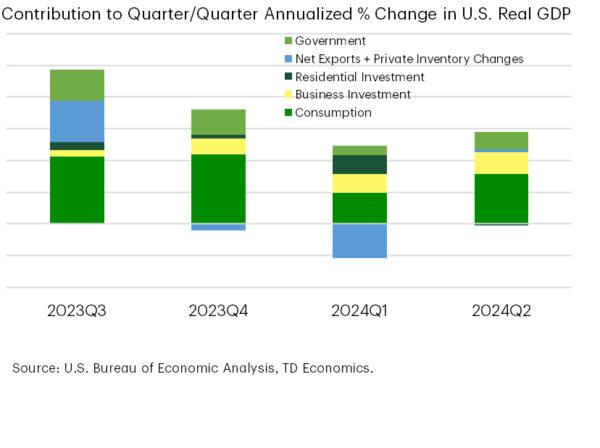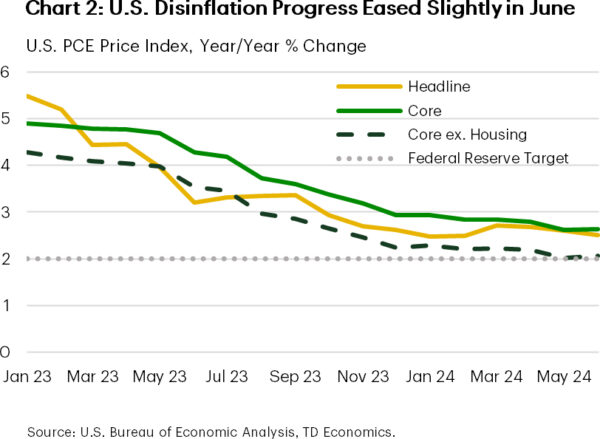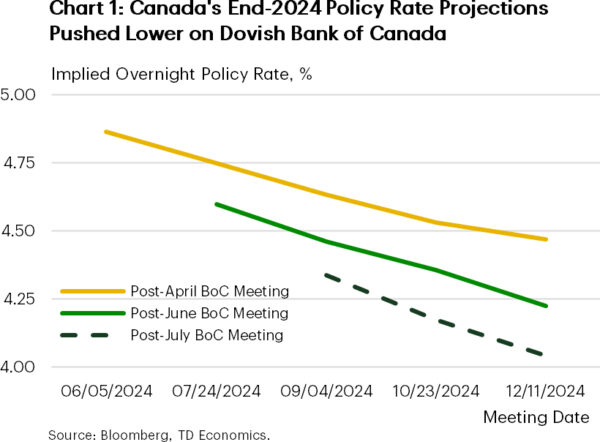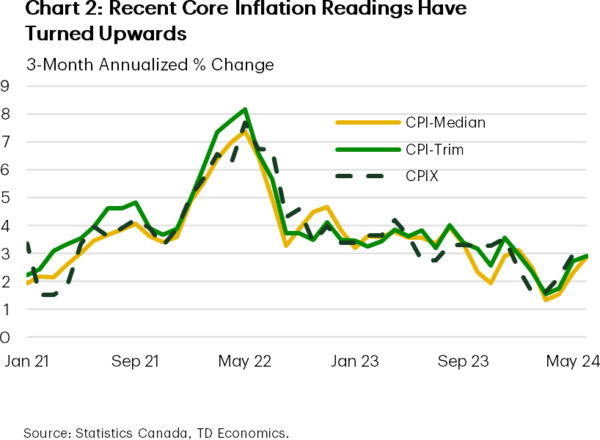U.S. Highlights
- The U.S. economy accelerated in the second quarter, growing by 2.8% (annualized), up from 1.4% in the first quarter.
- At the same time, inflation cooled to 2.5% year-on-year (y/y) in June, as measured by the personal consumption expenditure deflator. However, the Fed’s preferred inflation metric, core PCE, was unchanged relative to May.
- High interest rates continued to burden the housing market in June, as existing home sales fell 5.4% month-on-month.
Canadian Highlights
- The Bank of Canada lowered its policy rate by a second straight 25 basis points, taking the overnight rate to 4.50%.
- The Bank’s communications took a dovish turn, pushing forecasters to bump up their expectations for the pace of future rate cuts.
- Economic projections in the updated Monetary Policy Report (MPR) suggest that Canada’s economy will achieve a soft-landing.
U.S. – All Eyes on Next Week’s Fed Meeting
With the second half of the year now well under way, data this week showed a fairly Goldilocks outcome for the U.S. economy. Growth momentum coming out of the first half of the year was broadly favorable, while at the same time, inflationary pressures are cooling. In financial markets, company earnings reports out this week were mixed on aggregate, with weakness among the large tech firms dragging the S&P 500 down by 0.9% on the week as of the time of writing. U.S. Treasury yields also fell modestly on Friday’s PCE inflation report as markets wait to hear from the Federal Reserve next week.
Starting the week off on Tuesday, June housing data showed that existing home sales fell sharply to end the second quarter, fully retracing the uptick seen in the first quarter. However, this has not translated into material price adjustments, as the median home sales price in June was only a half-step off its all-time high seen in the month prior. With expectations growing for lower interest rates in the second half of the year, it’s possible that some buyers are biding their time.
The decline in the housing market shaved a marginal amount off real GDP growth in the second quarter, but solid growth in consumption, business investment, and government spending pushed the quarterly annualized growth rate to 2.8%, up from 1.4% in the first quarter (Chart 1). Growth in final sales to private domestic purchasers (excluding government spending and private inventory adjustments) was unchanged relative to the first quarter, as stronger consumption was offset by weakness in the housing market. Looking ahead, we expect that growth will moderate through the second half of the year but remain near the long-run average as the Federal Reserve begins to lower rates in the coming months.

To that end, inflation data released on Friday was slightly mixed on aggregate. Although headline PCE inflation declined modestly, core PCE inflation on a year-on-year basis was unchanged owing to a marginal acceleration in core PCE ex. housing, which offset a deceleration in housing inflation. Nevertheless, with housing inflation expected to continue to moderate moving forward and annual core PCE ex. housing inflation still in-line with the Fed’s 2% target (Chart 2), this report will not likely sway the Fed’s confidence about disinflation progress to a great degree.

Looking ahead, on the one-year anniversary of the last time the Fed hiked rates, Chair Powell is expected to begin opening the door to the possibility of a near-term pivot to rate cuts during his press conference next week. Financial markets have fully priced in the first cut occurring in just under two months at the September meeting, with an additional 2-3 cuts expected by year-end. However, overall guidance from the Fed next week is expected to emphasize caution and flexibility. Given the flare up in inflation in the first quarter, the Fed is going to want to be quite confident that inflation will continue to move in the right direction. On the other side of the Fed’s dual mandate, the second-last employment report before the September meeting, out next Friday, will also be monitored closely to determine whether the deceleration in job growth in the second quarter carried into the third.
Canada – Who Let the Doves Out?
The Bank of Canada (BoC) forged ahead with a second consecutive interest rate cut this week, bringing its policy rate down by 25 basis points (bps) to 4.50%. The move was widely expected and confirms that the BoC has now firmly entered into their rate easing cycle. The path forward is more uncertain, but the meeting’s dovish tilt suggests that the Bank is not hesitant to push rates lower in the near-term. As a result of the decision and communications, markets are pricing a 75% probability of an interest rate cut in September, and fully pricing in a 4.00% policy rate (two cuts) by the end of the year (Chart 1). Yields bull steepened with short-end rates falling around 10 bps on the week, while the CAD settled half a cent lower to 0.7240/USD.

The message is clear: “If inflation continues to ease broadly in line with our forecast, it is reasonable to expect further cuts in our policy interest rate.” New in the BoC’s messaging was the emphasis on the downside inflation risks via excess supply and its increased weight in monetary policy discussions. This is an important shift in sentiment, as it’s indicative of a central bank concerned about needing a less restrictive rate environment to limit potential economic weakness.
For the Bank’s part, they continue to acknowledge the progress on inflation, and we wouldn’t disagree. Headline inflation has registered under 3% year-on-year (y/y) for six consecutive months and the breadth of price increases across CPI components is near its historical average. However, while core measures have also softened within the Bank’s target range, we continue to flag that near-term growth rates for the BoC’s preferred core measures have accelerated.

Economic forecast updates in the Monetary Policy Report were modest compared to April’s issue but continue to highlight a soft-landing scenario for the economy. Despite shaving 2024 annual GDP growth to 1.2%–due to a weaker first half of the year—growth projections ratchet up to north of 2% for 2025 and 2026.
The buildup of slack in the labour market is of particular interest for the inflation projection. The BoC appears to have some reservations about whether the federal government will hit its target to rein in non-permanent resident growth by 2027. The BoC’s expectation for relatively stronger population growth in an economy with an already normalized job vacancy rate suggests the labour market is expected to loosen further. With wage sensitive services prices powering inflation, an expectation of growing excess supply in the labour market would help contain the recent uptick in core prices.
The BoC’s next interest rate announcement is on September 4th. Governor Macklem reiterated their data-dependent decision making, balancing the upside pressures from shelter and other services against ongoing excess supply. While the labour market has undoubtedly softened, if the recent uptick in core inflation is sustained, it could be the fly in the ointment for the BoC.









